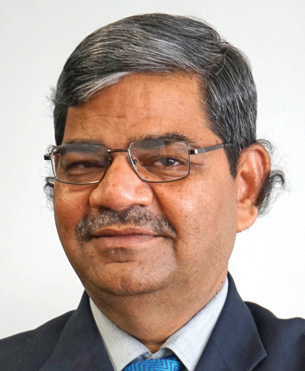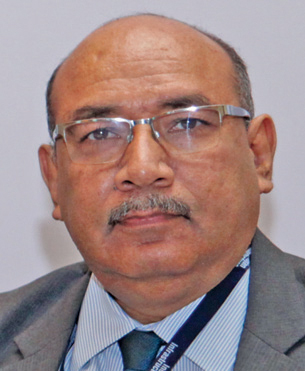Significant developments such as the adoption of the Insolvency and Bankruptcy Code and the Reserve Bank of India’s (RBI) stringent regulatory prescription for the resolution of stressed assets has weakened the investor sentiment over the past year. Lenders called for a more pragmatic approach to address the deep-rooted sectoral issues. Leading financiers shared their views on the sector’s performance and outlook…
How do you think the sector has progressed in the past year? What have been the major positive and negative developments?

Pawan Kumar Agarwal
The year 2017-18 has been one of the most important and dynamic years in the growth of the renewable energy sector in India. For the first time ever, India added more generation capacity from renewable sources in a year than from all conventional sources combined. This is in sync with the government’s goal of reaching 227 GW of installed renewable energy capacity in the country. There were many significant developments including the implementation of solar park projects, approval of wind-solar hybrids, introduction of offshore wind and repowering policies, issuance of new renewable purchase obligations (RPOs) and launch of a competitive bidding mechanism for wind projects. The sector also witnessed significant consolidation with a series of mergers and acquisitions including the acquisition of Ostro Energy by ReNew Power and Actis LLP’s acquisition of Bhoruka Power’s assets.
The renewable energy movement in the country has picked up steam owing to multiple factors. Renewable power is now significantly cheaper than conventional power. The government’s push to innovative methods of power generation like solar-wind hybrid systems, offshore wind projects and rooftop solar in collaboration with multilaterals like the World Bank and the Asian Development Bank is likely to aid sector growth. The government also needs to focus on boosting investor confidence. Meanwhile, tariff renegotiation, cancellation of conducted bids, unexpected policy path deviations, etc. can severely affect investor sentiment and lead to a slowdown in capacity addition.

Dr Ashok Haldia
The power sector has witnessed mixed progress. Initiatives towards the resolution of stressed assets, such as the adoption of a mechanism provided under the Insolvency and Bankruptcy Code and the Reserve Bank of India’s (RBI) stringent regulatory prescription disciplining delinquent loan accounts, have unsettled the thermal and hydro projects already crippled by fundamental issues. Stressed projects are eluding solutions leading to their revival. The churning out process has reached a decisive phase at the National Company Law Tribunal (NCLT). As it progresses, its success or challenges would determine the future direction for the power sector. However, there has not been worthwhile progress in enhancing the underlying viability of stressed projects by improving the health of discoms, facilitating the signing of new power purchase agreements (PPAs), ensuring adequate coal supply and overcoming implementation hurdles.
Solar and wind power continued to be a growth story. However, future growth would be dependent on the financial health of discoms, and resolution of transmission connectivity and land acquisition problems. Investors and lenders fear that the PPAs may not be honoured in letter and spirit throughout their tenor. Imbalances in generation, transmission and distribution continue. The government’s Power for All scheme is positive as it has the potential to drive the power demand.

P.R. Jaishankar
The past year has been quite eventful for the power sector with transformational changes resulting from the traction it gained and the introduction of several new policies. Power generation witnessed a growth of about 4 per cent in fiscal year 2018 and India’s installed generation capacity stood at over 344 GW as of June 2018. In the renewables space, the installed renewable generation capacity increased by over 10 GW during the year, coming closer to the government’s target of 175 GW of installed renewable capacity by 2022. Energy requirement also grew by about 5.5 per cent during the year owing to the rise in demand from the domestic and industrial segments. Meanwhile, the country’s interregional power transmission capacity increased by over five times at the end of 2017-18 from 2006-07. The strengthening and expansion of regional and intra-state grids along with improvements in rural electrification have eased grid congestion and supply constraints.
Under the Ujwal Discom Assurance Yojana (UDAY), the issuance of 86 per cent of the total bonds required to transfer the high-cost discom debt to lower-cost state government debt, and some level of tariff revisions to correctly reflect the cost of operations carried out by 25 of the total 27 member states have not only reduced the debt burden on discoms but have also led to improvement on the operational front. The reduction in the average cost of supply-average revenue realised gap and the aggregate technical and commercial (AT&C) losses by more than 50 per cent and 400 basis points respectively under the scheme is also a sign of positive development. While UDAY has helped in tackling the immediate crisis of payment to discoms, it does not seem to offer a permanent solution. Structural and operational reforms need to be formulated to cut down administrative, T&D and AT&C losses.
Under the Scheme to Harness and Allocate Koyla (Coal) Transparently in India (SHAKTI), coal linkages have been granted to 10 power plants with about 12 GW of aggregate capacity. The government launched the Pradhan Mantri Sahaj Bijli Har Ghar Yojana (Saubhagya) in September 2017. The scheme is expected to increase the demand for power and benefit power generating companies currently saddled with excess capacity, as well as help financially distressed distribution companies recover some of their costs. India also hosted the International Solar Alliance in March 2018, to focus on solar power utilisation, presenting itself as a leader in the global clean energy transformation.
However, issues pertaining to discoms persist. With respect to the availability of fuel sources, the operational performance monitoring division of the Central Electricity Authority recently reported about capacities in states like West Bengal, Gujarat and Andhra Pradesh being offline due to shortage of coal supply. One private player in the thermal power segment shut down a plant for the same reason. On the operations front, plant load factors (PLFs) declined as a result of a mismatch between power demand and availability of conventionally installed generation capacities. While average PLFs of coal-based power plants declined to approximately 60 per cent, PLFs of regasified liquefied natural gas (R-LNG) were as low as around 22 per cent in 2017-18. There has also been a decline in announcements for fresh PPAs by discoms. While several steps have been taken by the government to bring about improvement in the power sector, these are expected to show positive results in the long run only.
What should be the government’s topmost policy priorities for addressing the sector’s challenges?
Pawan Kumar Agarwal
Transparent bidding and facilitation of solar and wind power procurement through tariff-based competitive bidding have led to a significant reduction in the cost of solar and wind power. However, the government still has a lot of work to do. One of the major challenges currently being faced by the industry is uncertainty over GST applicable on renewable energy projects. There have been two different rulings by the State Authorities for Advance Ruling for recognising engineering, procurement and construction (EPC) contracts either as supply contracts or composite works contracts. Since both contracts attract different slabs of the goods and services tax (GST), the industry is facing a conundrum regarding the applicable rates, especially since electricity supply is not subject to GST. The Ministry of New and Renewable Energy (MNRE) had to provide an extension in the commercial operation date to projects affected by these orders.
Recently, various implementing agencies have cancelled their auctioned capacity citing discovered tariffs being higher than expected. The cancellation of auctioned capacity post a transparent bidding process has affected investor confidence, which has resulted in several bids being undersubscribed. One area where the government is continuously working to succeed is solar cell/module manufacturing. Currently, around 90 per cent of the modules used in India are imported (mainly from China). The government is trying to enhance the manufacturing capabilities, and investors’ and developers’ feedback and revisions in the recent tender should be a step forward in that direction.
Dr Ashok Haldia
The government’s top priority should be to improve the viability of the sector. Measures should be taken to improve the financial health of discoms, facilitate open access, and provide access to affordable quality power to every household. This will increase the demand for power and the discoms’ ability to meet that. Side-by-side efforts are required to remove generation bottlenecks particularly in coal availability and transmission capacity. The stress in the sector needs project-by-project prescription and collaborative action by all stakeholders. Exit through the NCLT or otherwise may rationalise the balance sheet but not necessarily its viability, which is fundamentally impaired by the lack of PPAs or non-availability of coal or infrastructure logistics.
P.R. Jaishankar
The recent policy-level changes and effective implementation of directives has not only alleviated the financial stress but has also brought operational efficiencies in the sector and improved India’s global ranking as both producer and consumer of electricity. The government needs to focus on all the aspects of the power sector as overlooking any one of them undermines the success of policies directed to tackle other aspects. There is a need to focus on capacity enhancements, which can best come out by recycling of existing operational assets. However, public investments have already reached high proportions and increased private sector participation is required. If budgetary support for capacity enhancements is continued, it would put additional pressure on the twin deficit of current account deficit and fiscal deficit.
The public sector is best suited for the creation of assets and value, and operations of these assets need to be undertaken by the private sector to add to the asset value. The securitisation of the existing capacities must be looked at to fund new capacity enhancement and addition. The increased value through securitisation should be monetised to enhance further capacity. There is also a need to bring policy changes on political aspects to enhance the ease of doing business for developers. A recent move of the government, wherein the MNRE removed the mandatory registration for renewable projects with respective state nodal agencies is an example.
Schemes like UDAY will help overcome some of the financial challenges facing the sector. However, the recent RBI guidelines on the resolution of stressed assets issued through a circular dated February 12, 2018, and the denial of requests to relax the timeline for the resolution of stressed power projects could adversely affect financials and increase funding constraints especially for thermal power producers. There is also a need to speed up the implementation of the SHAKTI scheme. Although several measures have been initiated by the government, robust pick-up in power demand is crucial for the revival of the stressed generation segment. In this regard, schemes like Saubhagya and the Smart Cities Mission will play a key role.
Development on the technological front is equally important to bring transparency in the execution of all government schemes and missions, and make monitoring feasible with easy access to progress reports for all stakeholders. Dashboards developed for SHAKTI, UDAY, Saubhagya and portals like PRAAPTI (Payment Ratification and Analysis in Power procurement for Bringing Transparency in Invoicing of Generators) will bring in a new level of transparency, with respect to on-ground status and financial transactions in the power sector. Delays in land acquisition, rehabilitation, and environment and forest clearances are other factors hampering the development of the power sector as they delay the commissioning of projects. The government, with the help of other stakeholders, needs to prioritise these issues and come up with directives to clear the regulatory logjam. The government is considering easing the mandatory 80 per cent land acquisition condition for highway construction to speed up road building and launch new projects. Something similar could be initiated in the power sector as well.
What is the investment outlook for the sector over the next one to two years?
Pawan Kumar Agarwal
With renewable energy targets second only to those set by China, India has a long way to go from a current base of 60 GW to reach its targets in the next five years. The government recently announced that it will tender enough capacity over the next three years to surpass 200 GW of green capacity build by 2022. In 2016-17, India witnessed $10 billion renewable energy investment, of which corporate funding accounted for 65 per cent (on account of 9 GW of capacity addition). There have been $380 million worth of corporate funding (private equity/venture capital) deals in the solar sector space and of $3 billion in the wind energy space in the first half of 2018. With competitive bidding, only a few start-ups in the renewables space are able to compete and survive in the low-tariff environment, and hence, VC/PE financing is expected to see fewer, but larger, deals over the next few years. Moreover, once the market stabilises and capital costs fall in tandem, margins will also stabilise creating opportunities for more companies to compete.
Dr Ashok Haldia
The investment outlook in the sector will see directional change. Investors and lenders will be more risk conscious, and more prudent and disciplined. The availability of stressed power projects at throwaway prices may find investors and lenders may find these as lending opportunities for term loans and mezzanine funding. Transmission projects, particularly interstate projects, will get an investment preference owing to lower risks. Investment conditions in the wind and solar power segments are likely to remain fluid at least for the next six months. This will be dependent on state-specific factors and on the perception of risk and mitigation thereof in projects under bids.
P.R. Jaishankar
The government has come up with many multi-pronged schemes focused on improving the financial condition and operational efficiency of utilities. A $5.8 billion green energy corridor is being set up to ensure the efficient evacuation of renewable energy in the next three to four years. The scheme for Development of Solar Parks and Ultra Mega Solar Power Projects with an approved capacity of 40,000 MW entails the setting up of at least 50 solar parks, with a capacity of over 500 MW each and a planned central government financial support of Rs 81 billion. The solar parks and ultra mega solar power projects will be set up by 2019-20. The government is looking to generate 2 trillion units (kWh) of energy by 2019, which requires doubling the current production capacity to provide 24×7 electricity. Further, the upcoming 100 smart city projects will provide huge scope for renewable energy development. As per estimates, around Rs 15,000 billion worth of investment is required in the power sector during 2018-22. This accounts for around 30 per cent of the total investment required in the infrastructure sector over the same period. As a key financier to the power sector in India, IIFCL has sanctioned over Rs 450 billion fund-based loans under direct lending and takeout finance schemes, and about Rs 16 billion non-fund-based loans under credit enhancement as of June 2018, to nearly 200 power projects across various states in the country. We intend to enhance our contribution to the sector in the future as well.
